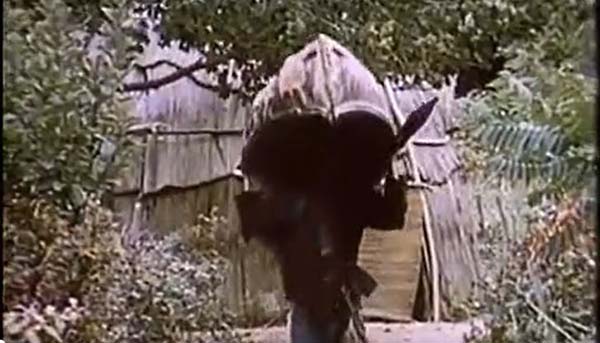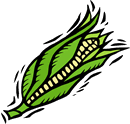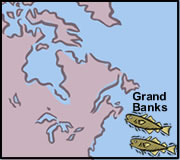| |

OUR NEW HAMPSHIRE
People of the Dawn


View Video
Background Information The first wave of human settlement of the American continent came out of northern Asia, across the narrow Bering Strait, and then fanned out southward and eastward across North America.
Some 10,000 years ago it reached New England. It stopped by the shores of the Atlantic, where eventually it met another wave of settlement flowing westward out of Europe. When the first wave arrived, the forests that now cover 85% of the state were still several thousands of years in the future. The land was then covered with low growing brush and grasses and food was scarce.
The people who lived in northern New England, whose canoes cut the waters of the Connecticut, the St. Lawrence, Massachusetts Bay, and Cape Cod Sound, were called by many names, but the most common name is Abenaki, or "People of the Dawn".
 Around 3,000 years ago, the Abenaki of New Hampshire made a great change in their life style. Although they still hunted deer and moose and bear, they also added the practice of planting and tending the four "sacred plants"--corn, beans, squash, and tobacco. According to Abenaki legend, the corn was brought to them from the southwest in the eye of the crow--thus, they never killed the crows who came to raid their fields, but merely scared them away. Around 3,000 years ago, the Abenaki of New Hampshire made a great change in their life style. Although they still hunted deer and moose and bear, they also added the practice of planting and tending the four "sacred plants"--corn, beans, squash, and tobacco. According to Abenaki legend, the corn was brought to them from the southwest in the eye of the crow--thus, they never killed the crows who came to raid their fields, but merely scared them away.

The practice of agriculture brought great changes to the lives of the New Hampshire Abenakis. Unlike their cousins to the north, where the growing season was too short to ripen corn to a hard stage that would keep through the winter, the New Hampshire Abenaki could store some of their crops in underground pits. Because they had stored food, they didn't need to hunt as much and could spend their winters in villages.
 They also had more time trapping for animals like beavers. This prepared them for the second great change in the Abenaki way of life. In the early 1500s, European fishermen were fishing for cod, haddock, and other fish found in the Grand Banks. The Grand Banks are
a series of raised submarine plateaus found off the southeast coast of Newfoundland and are one of the richest areas in the ocean for fish. The European fisherman who fished off the coast of Canada and northern New England eventually came ashore and began to trade with the Abenaki. They also had more time trapping for animals like beavers. This prepared them for the second great change in the Abenaki way of life. In the early 1500s, European fishermen were fishing for cod, haddock, and other fish found in the Grand Banks. The Grand Banks are
a series of raised submarine plateaus found off the southeast coast of Newfoundland and are one of the richest areas in the ocean for fish. The European fisherman who fished off the coast of Canada and northern New England eventually came ashore and began to trade with the Abenaki.
For the Abenaki, the new coastal trade meant it was easier to get better tools. They no longer had to trade with their old enemies, the Iroquois, for the "good stone from the west." The European newcomers had better ax heads and wonderful metal pots and blankets which were almost as warm as a woven rabbit skin blanket and far less work to get. Tanning skins was very hard work, and the newcomers would often trade a whole blanket for a single beaver skin.
SUMMARY
This episode depicts Native American life as it was lived in New Hampshire before the European settlers arrived. Perhaps because knowledge of this topic is so limited, it would be more accurate to say that the lesson "suggests" rather than "depicts." History and archaeology provide us with some clues about life during this time, but not much solid information. Given these limitations, however, the lesson captures images that are as faithful as possible to the way of life of the people who lived here 500 years ago.
The events occur in the 16th century, when contact with European fishermen and fur traders had already affected Native American life, through the introduction of metal implements and woolen blankets. Trade with the white man, however, had not yet seriously disrupted the natives' traditional culture.
From a mass of conflicting evidence, we have chosen the name "Abenaki" as the best overall name for the native inhabitants of New Hampshire. This name stresses their relationship with their cousins to the north, on the Saco and other northern rivers. However, the culture of the New Hampshire tribes was more like that of their relatives in Massachusetts, Connecticut, Rhode Island, and Long Island. Most of the natives of New Hampshire--the loose Penacook Confederacy of the Merrimack and the camps along the Connecticut and on the shores of the Great Bay--shared with their southern kinsmen a growing season long enough to allow them to raise corn to the hard-ripe stage, in which form it could be stored for the winter. In this sense, they were different from their northern relatives, who were forced to split up into small family groups and spread out during the winter to hunt game wherever they could find it. The important fact is that New Hampshire's natives were primarily farmers.
The video lesson concentrates on the material culture of the Abenaki, not because this is more important than the social, artistic, and religious aspects of their lives, but simply because so little is known of these latter aspects. The lesson shows the Abenakis at work: gardening; harvesting corn, tobacco, and squash; gathering fish and shellfish; and preparing and cooking food. Also shown is the typical home of the Abenaki, the wigwam, constructed of two layers of woven rushes. Other activities presented in the lesson include the preparation of skins for tanning, the building and use of the canoe (one of the greatest inventions of the native American), and the making of stone tools.
The lesson concentrates on the annual cycle of the day-to-day life of the Abenaki. Amidst the everyday activities, it is hoped, the viewer will be able to recognize and appreciate the tone and complexity of the civilization of the native American of New England: courteous, dignified, gentle, and above all else, very much at home and in harmony with their own land.
OBJECTIVES
1. Students will describe some of the characteristics and complexities of New Hampshire Indigenous life before European settlement.
2. Students will describe the relationship of the Abenaki to their environment and the dependency of their lifestyle on the seasonal cycles of nature.
3. Students will discuss how New Hampshire Indigenous people and their culture are an integral part of of New Hampshire's past and future..
4. Students will describe the ingenuity and frugality with which the Abenaki used materials and natural resources.
5. Students will describe, explore, and challenge some of the stereotypes surrounding Indigenous people and their culture.
6. Students, through an exploration of the historical background of Indigenous people, will articulate an interest in and concern for the contemporary Indigenous peoples.
PRE-VIEWING ACTIVITIES
1. Discuss with students their present understanding of the history and culture of the American Native American. Explore with them some of their attitudes toward these Indigenous peoples and the origins of these attitudes. Examine some stereotypes surrounding North American Indigenous people ("noble savage," ignoble savage, victim, simplistic life style).
2. Have students bring to class pictures, artifacts and various accounts of North America Indigenous peoples. Construct a museum within the room, displaying the items.
3. As a class, read or tell a few North America Indigenous legends, listen to North American Indigenous music or stories.
4. Ask students to keep a list of North America Indigenous names attached to New Hampshire towns, cities, rivers and other geographical locations. These may be compiled from actual student travel or maps of New Hampshire.
POST-VIEWING ACTIVITIES
1. Make one or more of the following:
- Indigenous crafts (small birchbark canoe, snowshoes, leather moccasins, tools, Native American jewelry, Indigenous puppets, carved peacepipe, drum)
- diorama or clay model of various Indigenous settlements or methods of clearing land, planting crops, fishing, or other activities
- a display of Indigenous art or a visual menu of Indigenous foods
- a pressed collection of edible plants probably eaten by New England Indigenous people
- a map of the United States and/or New Hampshire, locating on it various Indigenous settlements and trails (especially local ones)
- a class mural depicting the lifestyle of the early New Hampshire Indigenous peoples
2. Develop a list of:
- possible early Indigenous concerns. Prioritize those concerns and brainstorm solutions.
- natural resources used by Indigenous people. Prioritize their importance.
- names and locations of various New England tribes and reservations.
- foods eaten by students in one week that were also foods eaten by Indigenous people.
- New Hampshire Indigenous names for places like local towns, streets, lakes
- various Indigenous organizations. Write to them to obtain additional information on Indigenous culture.
- questions about present-day Indigenous people. Write to the Bureau of Indian Affairs for answers and for information on special Indigenous programs.
3. Organize and participate in:
- a skit of early Indigenous life or a puppet re-enactment of Indigenous legends.
- a role play of an Indigenous Council meeting concerned with resolving some Indigenous problem.
- an Indigenous pow-wow.
- Read Indigenous legends, watch films, listen to music, learn Indigenous dances, learn games and relays.
4. Invite a guest lecturer to class to speak about Indigenous affairs, crafts, or other related topics.
5. Do a class report on one of the following:
- compare and contrast the life style of New Hampshire Indigenous people with that of other tribes throughout the country.
- become familiar with current issues important to today's Indigenous people (land-claim, fishing rights, reservation life, unemployment, alcoholism).
- investigate how the arrival of European settlers changed the lives of Indigenous people.
- for one New England tribe, explore: Indigenous reverence for nature, family life, village life, education, folklore, religious beliefs, taboos, music, ceremonies, politics, trades and skills, male and female roles, law, language, survival skills, economics.
- become familiar with the lives of different Indigenous chiefs: Passaconaway, Wonalancet, Paugus, Kancamagus, Chocorua.
- explore some of the contributions of the New Hampshire Indigenous people to our everyday lives.
- Investigate various NH archaeological evidence of local Indigenous culture.
6. Study various woodland survival skills concerning food, clothing and shelter
VOCABULARY
- Abenaki
- quahog
- dugouts
- Algonquin
- wampum
|
- kinnikinik
- Penacook
- birchbark
- sinew
- mortar & pestle
|
- artifacts
- ancestors
- wigwam
- shellfish
|
PLACES TO VISIT
PLACES TO KNOW
- Pemigawasset
- Mascoma
- Piscataqua
- Kancamagus Highway
- Connecticut River
ORGANIZATIONS/MUSEUMS
WEB RESOURCES
|
|